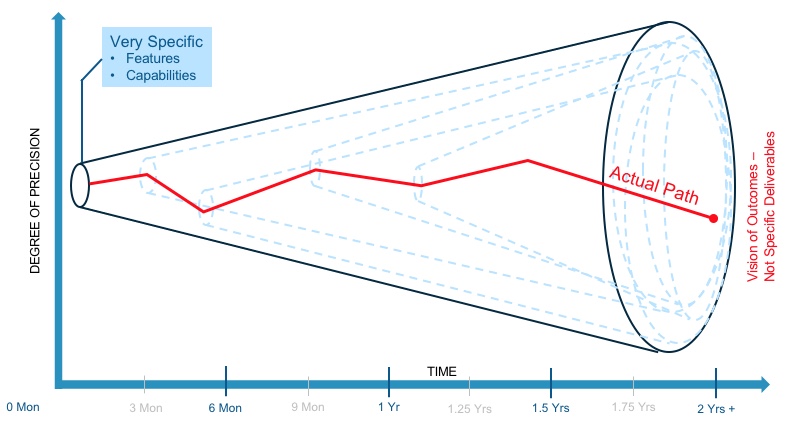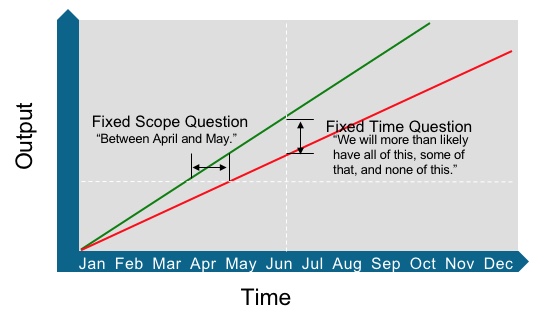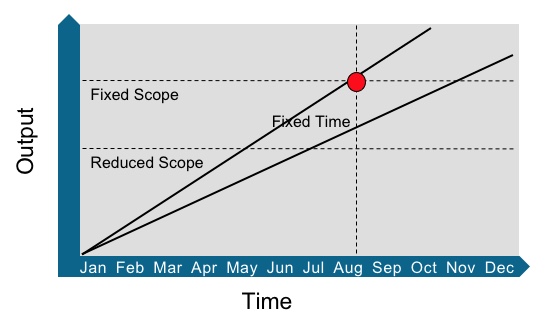The Leap of Faith
When we embark on building SaaS product that will delight customers we are taking a leap of faith. We often don’t even know whether or not the outcomes targeted are possible. Investing and building software is often risky for several reasons:
- We don’t know what the market wants.
- The market is changing around us.
- Competition is always improving their time to market (TTM) releasing competitive products and services.
We have to assume there will be project assumptions made that will be wrong and that the underlying development technology we use to build products is constantly changing and evolving. One thing is clear on the SaaS journey – the future is always murky!
The journey that’s plagued with uncertainty for developing SaaS is seen throughout the industry and is evidenced by success and failure from big and small companies – from Facebook to Apple to Salesforce to Google. Google is one of many innovating B2C companies that have used the cone of uncertainty to help inform how to go to market and whether or not to sunset a service. The company realizes that in addition to innovating, they need to reduce uncertainty quickly.

For example, Google Notebook, a browser-based note-taking and information sharing service, was killed and resurrected as part of Google Docs and has a mobile derivative called Keep. Google Buzz, Google’s first attempt at a social network was quickly killed after a little over a year in 2011. These are just a few B2C examples from Google. All of these are examples of investments that faced the cone of uncertainty. Predicting successful outcomes longer term and locking in specifics about a product will only be wasteful and risky.
The cone of uncertainty describes the uncertainty and risk that exist when an investment is made for a software project. The cone depicts the amount of risk and degree of precision for certainty thru the funnel. The further out we try to forecast features, capabilities, and adoption, the more risk and uncertainty we must assume. This is true for what we attempt to define as a product to be delivered and the timing on when we will deliver it to market. Over time, firms must make adjustments to the planned path along the way to capture and embrace changing market needs.
In today’s market we must quickly test our hypothesis and drive innovation to be competitive. An Agile product development life cycle (PDLC) and appropriately aligned organization helps us to do just that. To address the challenge the cone represents, we must understand what an Agile PDLC can do for the firm and what it cannot do for the firm.
Address the Uncertainty of the Cone
When we use an Agile approach, we must fix time and cost for development and delivery of a product but we allow for adjustment and changes to scope to meet fixed dates. The team can extend time later in the project but the committed date to delivery does not change. We also do not add people since Brooks Law teaches us that adding human resources to a late software project only delays it further. Instead we accelerate our ability to learn with frequent deployments to market resulting in a reduction in uncertainty. Throughout this process, discovery of both what the feature set needs to be for a successful outcome and how something should work is accomplished.

Agile allows for frequent iterations that can keep us close to the market thru data. After a deployment, if our system is designed to be monitored, we can capture rich information that will help to inform future prioritization, new ideas about features and modifications that may be needed to the existing feature set. Agile forces us to frequently estimate and as such produce valuable data for our business. The resulting velocity of our sprints can be used to revise future delivery range forecasts for both what will be delivered and when it will be delivered. Data will also be produced throughout our sprints that will help to identify what may be slowing us down ultimately impacting our time to market. Positive morale will be injected into the tams as results can be observed and felt in the short term.

What agile is not and how we must adjust?
While using an Agile method can help address the cone of uncertainty, it’s not the answer to all challenges. Agile does not help to provide a specific date when a feature or scope will be delivered. Instead we work towards ranges. It also does not improve TTM just because our teams started practicing it. Company philosophies, principles, and rules are not defined through an Agile PDLC. Those are up to the company to define. Once defined the teams can operate within the boundaries to innovate. Part of this boundary definition needs to start at the top. Executives need to paint a vivid picture of the desired outcome that stirs up emotion and can be measurable. The vision is at the opening of the cone. Measurable Key Results that executives define to achieve outcomes allow for teams to innovate making tradeoffs as they progress towards the vision. Agile alone does not empower teams or help to innovate. Outcomes, and Key Results (OKRs) cascaded into our organization coupled with an Agile PDLC can be a great combination that will empower teams giving us a better chance to innovate and achieve desirable time to market. Implementing an OKR framework helps to remove the focus of cranking out code to hit a date and redirects the needed attention on innovation and making tradeoffs to achieve the desired outcome.
Agile does not align well with annual budget cycles. While many times, an annual perspective is required by shareholders, an Agile approach is in conflict with annual budgeting. Since Agile sees changing market demands, frequent budget iterations are needed as teams may request additional funding to go after an opportunity. It’s key that finance leaders embrace the importance of adjusting the budgeting approach to align with an Agile PDLC. Otherwise the conflict created could be destructive and create a barrier to the firms desired outcome.
Applying Agile properly benefits a firm by helping to address the cone and reducing uncertainty, empowering teams to deliver on an outcome, and ultimately become more competitive in the global marketplace. Agile is on the verge of becoming table stakes for companies that want to be world class. And as we described above noting the importance of a different approach to something like budgeting, its not just for software – it’s the entire business.
Let Us Help
AKF has helped many companies of all sizes when transitioning to an organization, redefining PDLC to align with desired speed to market outcomes, and SaaS migrations. All three are closely tied and if done right, can help firms compete more effectively. Contact us for a free consultation. We would love to help!